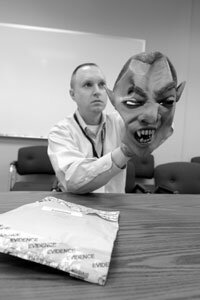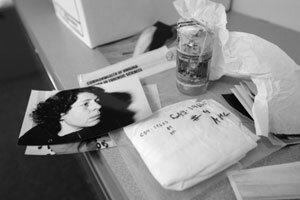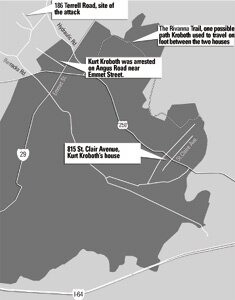Horror in the hallway: Masked assailant faces sentencing

When Kurt Kroboth went to the Charlottesville Wal-Mart in the fall of 2004 and bought a vampire mask, his purchase probably didn't raise any eyebrows. After all, it was October 26– five days before Halloween– and Kroboth, a well-heeled financial consultant and film buff, was hardly the only shopper preparing for the holiday.
He may have been the only one plotting a murder, however. On Halloween night, he now admits, he donned the mask and tried to kill his estranged wife by staging a mock suicide that ended up with a harrowing fight in an upstairs hallway.
And while the plot– a cross between the Michael Douglas-Kathleen Turner drama War of the Roses and horror flick Halloween– might not have won him an Oscar, it has won him two felony convictions; his sentencing is set for February 21 in Albemarle Circuit Court.
As he faces a virtual life sentence, friends wonder what could have driven the now 50-year-old Kroboth, whom they describe as "very smart" and "considerate," to commit such a crime.
The root of all evil
"It was greed," says Albemarle County Detective Phil Giles of Kroboth's motive.
Indeed, prosecutors alleged at trial that money was Kroboth's driving force. The Halloween night attack took place exactly one week before the Kroboths' divorce was to be finalized in Albemarle Circuit Court. That left Kroboth just a few days during which he could inherit all marital property without dispute.
And there was plenty to inherit.
In addition to the 4,000-square-foot house the couple built on Terrell Road in 1999 (currently on the market for $945,000), they had purchased a second home on St. Clair Avenue in the city in 2002 as a residence for Kroboth when the marriage began to unravel. All that was in addition to a rental property in Wisconsin, retirement accounts and other investments. In all, court records reveal that a 2004 appraisal set the couple's worth at more than $1.6 million.
And that did not include Kroboth's six-figure income. A mergers and acquisitions expert, he worked on multi-million-dollar deals as a consultant for a New York-based firm called CFC Capital. According to tax records in the court file, Kroboth– who has two graduate degrees including an MBA from Columbia University– earned more than $200,000 in 2000, and had an average annual income of about $130,000 between 1999 and 2003. Jane Kroboth, a stay-at-home mom to their two sons, volunteered for the Virginia Autism Institute.
The issue of custody was particularly heated between the couple. At the time of the murder, they were sharing custody of their 13- and 14-year-old sons, though Jane had primary physical custody and was pressuring Kurt to keep the children away from his girlfriend during the boys' visits.
But, according to prosecutors, while the custody fight may have angered Kroboth, it was the child and spousal support he was ordered to pay that pushed him over the edge.
In July 2004, the court had ordered Kroboth to pay monthly support to Jane in excess of $6,000. According to court documents, Kroboth claimed the sum was nearly 75 percent of his $8,710 gross monthly income– in effect, more than 100 percent of his after-tax, take-home pay.
"The defendant was extremely upset," said Commonwealth's Attorney Cynthia Murray at Kroboth's January 24, 2005 hearing, "to the point of being obsessed with the court's determination, and sought to kill his wife, Jane Kroboth, because he saw her as being the source of his problems."
Marital trouble
Married in 1986 in Fremont, California, the Kroboths had attained all the external trappings of success by the time they moved to Albemarle in the 1990s– two children and soon a stately home they designed and built themselves.
But as emails contained in their divorce file reveal, the marriage had begun to deteriorate, and in 2001 and 2002, they went to an unusual extreme to save their relationship: they opened the marital door– the bedroom door.
Kroboth was aggressive in his search for new mates. Trolling various Internet dating sites including yahoo.com, he had contacted no less than five potential sexual partners, whose correspondence litters the divorce file.
"I'm also happily married," Kroboth wrote in November 2001 to 32-year-old "cutenpetite2001" in Springfield, who described herself as "married but looking." And to Annalee40, he wrote, "Married 15 years, happy enough but not quite satisfied. I miss the excitement experienced in the first stages of a new relationship."
But if Jane had briefly acceded to Kroboth's plan for an "open marriage," her interest in the swinging lifestyle had waned by October 2002. And Kurt– by then seriously involved and claiming to be in love with a new girlfriend– had moved into the house on St. Clair Avenue in the Locust Grove neighborhood.
Though the couple made one last attempt at reconciliation in the fall of 2003, it wasn't long before the wheels of divorce were rolling, and the stage was set for Kroboth's final marital act: murder.
Halloween night
As his two sons slept, Kroboth left the house on St. Clair Avenue some time on Halloween night. It had been an unseasonably warm night for trick-or-treating with the day's high temperature, according to archived weather records, hitting 80 degrees.
Although the temperature plummeted after nightfall, the full moon had come just four days earlier, and the 49-year-old man with the vampire mask had clear skies and no appreciable wind to slow his nocturnal trek.
Upon reaching the Terrell Road house, like the so-called Manson family had done 35 years earlier at the infamous Tate mansion, Kroboth cut the phone lines. Unlike the killers of Sharon Tate, however, Kroboth, as he testified in court, also cut the electrical power to his wife's house.
Having lived in the home for three years, Kroboth knew the floor plan and his wife's habits.
He entered the house around 3:45am, while Jane was asleep upstairs. As a former friend would later testify, Kroboth's plan was to enter the master bedroom they'd once shared and knock his wife outwith a chloroform-soaked rag. Then he planned to take her to a bathtub and slit her wrists, a scenario suggesting that the middle-aged mom had taken her own life.
But this middle-aged mom fought back.
Awakened by a figure in a grotesque mask, Jane struggled with her attacker, whom she later testified she could not identify. Though he attempted to smother her with a pillow, she escaped his grip and ran out of the room onto a second-floor landing, where, according to court documents, Kroboth struck her in the face and repeatedly attempted to heave her over a railing to the first floor, nearly 15 feet below. He failed.
Premeditation
The 911 call came in at 4:09am November 1, says Thomas Hanson, director of the Emergency Communications Center. The caller, using her cell phone, described a masked attacker wearing latex gloves and explained that he had run out the door, Hanson says.
When police found Kroboth at the corner of Angus Road and Emmet Street soon after the attack, they quickly knew they had their man, according to one of the arresting officers.
"He seemed nervous," says Detective Phil Giles, adding that Kroboth, who'd been traveling on foot, was "cooperative" during the arrest but refused to give a statement.
Giles says that Kroboth's finger was red and swollen– Jane reported she had bitten her attacker's finger– and he had speckles of blood and a long black hair consistent with Jane's on his gray hooded sweatshirt– attire Jane had described her attacker wearing.
Inside Kroboth's "fanny pack," police discovered a latex glove, a knife, a small flashlight, and a jar of a "suspicious smelling chemical." And following a sweep of the surrounding neighborhood, they discovered a vampire mask and a piece of another latex glove in a trash can.
Following Kroboth's arrest, police went to his St. Clair Avenue home, where his car was parked and his sons were still sleeping.
Though Giles says police once considered that someone could have driven Kroboth to Terrell Road, they eventually determined he had acted alone by covering the three-plus miles on foot.
"It's not a long run," Giles says, mentioning the Rivanna Trail as one possible path Kroboth, an avid runner, could have taken from St. Clair to the Terrell Road area without being seen.
After determining that the children were unharmed, Giles says, police released them to Jane, who had been treated at the University of Virginia hospital for contusions and a broken nose.
Next, Giles says, police searched Kroboth's house, where the extent of his plan began to unfold. A copy of Jane's will– naming Kurt the sole beneficiary– was out on his desk, and a subsequent forensic analysis of his computer revealed thousands of hits for "chloroform" as well as several hits for "rosary tea," a deadly herb.
But the most damning evidence may have come from a witness who claimed that he had told police months before the attack that Kroboth planned to murder Jane.
Ayers-ing dirty laundry
At first, Kurt Kroboth was simply a gym acquaintance, a man named Michael Ayers testified in Circuit Court. But after Ayers was involved in a car accident in the spring of 2004, Kroboth became a good friend– a good friend with an open wallet.
Ayers– who'd spent nearly a decade in prison for his role in several burglaries– said he'd found religion and healed spiritually, according to court documents, but he still struggled financially. Kroboth, he testified, bought Ayers' young son toys and clothes and often paid Ayers' bills. He even gave him a car, a 1989 Audi.
But Kroboth's generosity eventually came with a string attached, Ayers said, a string that he wasn't willing to pull. Ayers testified that on several occasions, Kroboth offered him $10,000 to kill his wife.
It was Ayers (who could not be reached for comment for this story) who testified to the specifics of Kroboth's plan. Ayers said that Kurt talked of sedating Jane, carrying her limp body to the bathtub, filling the tub, and then slitting her wrists. It would look like the petite brunette had killed herself.
At first he thought Kroboth was joking, Ayers testified, but then he heard that Kroboth had made the same request of another man, a friend of Ayers, who'd also turned him down.
Soon, Kroboth and Ayers' friendship was on the rocks– and it ended completely when Kroboth contacted police to report Ayers for harassment and theft.
"Kroboth came to the station complaining he was getting these annoying phone calls," recalls Charlottesville police officer Phil Waufle, who also testified in the case.
Waufle testified that Kroboth claimed he had given Ayers a car and that Ayers "kept bothering him, saying this needs fixing and he should pay for it."
According to Waufle, Kroboth claimed Ayers had essentially stolen the car, and he asked Waufle for help. "All I want to do is get my car back, and he won't give it to me," Waufle testified Kroboth said.
On September 2, 2004, Waufle accompanied Kroboth to the Lucky 7 convenience store on East Market Street. The conflict, Waufle says, seemed overblown.
"Ayers said, 'You can have the thing back, just let me get stuff,'" Waufle recalls. Ayers then removed several children's toys and an alternator that belonged to him, and Kroboth got in the car and drove away.
After Kroboth left, however, Ayers had a different story for Waufle.
"He was telling me how this guy had come to him and asked him if he wanted to make some money," Waufle recalls.
After hearing about Kroboth's solicitations for Jane's murder, Waufle returned to the Charlottesville police station and filled out an incident report detailing the allegations, which he says he passed to his supervisors on September 2, 2004– two months before Kroboth's attack on Jane.
Waufle says his report was not investigated. And thus the Halloween horror caught the victim with her house unlocked and her guard down.
Ayers testified to his belief that if the city had investigated his claim, Kroboth could have been caught before he acted. "They could have prevented this," he said.
Did the city fail Jane Kroboth? She seems to think so. In a May 2005 letter, she notified the city of her intention to sue for "police negligence." Virginia law requires an individual intending to sue a city or town to give notice within six months of an incident.
"I did everything I was supposed to do," says Waufle.
Police Chief Tim Longo declined comment other than to express "concern" over the allegations, and City attorney Craig Brown says he's received no other communication from Jane Kroboth regarding a lawsuit. However, Jane's attorney, Ron Tweel, says a civil case may be waged by a Richmond law firm in the near future, though he declines to elaborate.
Pleas and no thank you
After his arrest, Kroboth hired prominent Charlottesville defense attorney Francis McQ. Lawrence and his associate Rhonda Quagliana. Faced with the amount of physical evidence in the original seven charges he faced, Kroboth agreed to plead guilty to two: attempted murder and breaking and entering with intent to commit murder while armed with a dangerous weapon.
But sometime after entering that plea on May 5, 2005, Kroboth changed his mind, asking the court to allow him to withdraw his guilty plea.
At what would have been Kroboth's sentencing hearing on August 2, 2005, Lawrence and Quagliana asked the court to recuse them and any member of their firm from serving as Kroboth's counsel. It is an ethical violation for a lawyer to be a witness in a case in which he is counsel, an eventuality that was likely in the Kroboth case, Lawrence and Quagliana said.
An outraged Kroboth wrote to Judge William Shelton, who had granted the attorneys' request to withdraw, asking him to force Lawrence and Quagliana's colleague Cheryl Higgins to represent him, and explaining why he had entered the guilty pleas.
Quagliana and Lawrence "took the case fully intending to have it end in a plea," Kroboth wrote the judge, "thereby earning a large fee for relatively few hours.
"They were clearly occupied by other cases and gave mine minimal attention," he continued in the hand-written letter from the Albemarle Charlottesville Regional Jail, "to the point of failing to investigate a key piece of evidence despite my pleas to do so for three months."
Kroboth's letter didn't specify the allegedly "key" piece of evidence, and Lawrence and Quagliana have declined comment for this story.
Finding a new lawyer from the Jail, where he has been incarcerated since his arrest, Kroboth explained to the judge, is "next to impossible," particularly after the conflict over his legal team's withdrawal had "effectively poisoned the well" with other local attorneys.
Kroboth eventually retained the services of attorney David Heilburg in August 2005, and with Heilburg's counsel, Kroboth once again changed his tack and returned to agreeing to the two guilty pleas.
On Heilburg's advice, Kroboth declined the Hook's request for an interview, but the attorney describes the back-and-forth pleas as the result of a simple misunderstanding.
"He thought he'd originally entered an Alford Plea," Heilburg explains, in which a defendant stops short of admitting to a crime but agrees that the prosecution has enough evidence to convict him.
But according to attorneys on both sides, Kurt Kroboth was under suspicion of domestic assault in early 2004.
"It was a 'run-of-the-mill' domestic assault," says Tweel, "pushing, shoving, that kind of thing." It turned into a "he said, she said" case, he explains. Jane, he says, refused to have her children testify against their father.
But Heilburg says the judge threw the charge out because it was without merit, and that prior to his attempted murder, Kroboth's record was clean.
Though there is now no question about the guilty pleas in the Halloween night attack, Heilburg has filed a motion to continue the sentencing hearing to gain an extra month to gather witnesses who can testify that Kroboth should be spared a harsh sentence.
"This is a man who's never done anything wrong before," he says.
Who was Kurt Kroboth?
To members of Kroboth's family, the crime came as a shock.
It "was so unbelievable to all who know and love him," write his parents, Harvey and Alice Kroboth, in a February 12 email to a reporter. "Just thinking about it is still giving us, his parents, many sleepless nights."
The Kroboths, who live in Wisconsin, describe their son as "very intelligent, very good in conversation with all kinds of people."
Indeed, Kroboth has a graduate business degree from Columbia as well as an MFA degree in film. He has lived abroad and is fluent in French. But beneath his intelligence and charisma, his parents say, is genuine kindness.
"He has always shown love, caring, and consideration for our welfare," they say, "and has helped us tremendously in many ways, at many times."
That generosity extended beyond his family.
One of Kroboth's neighbors on St. Clair Avenue, an elderly woman who asks to remain anonymous, says she too benefited from Kroboth's giving nature. "He was always offering to help me," she says, recalling him carrying groceries and performing other chores for her around her property. "He was such a nice man."
It's hard to reconcile her experiences with Kroboth, she says, with the harsh reality of his crime.
How did she survive?
No doubt Jane's experience mimics many women's worst nightmare– awakened in the middle of the night by a murderous, masked assailant. But somehow Jane Kroboth was able to fend off her attacker.
One local self-defense instructor says Kroboth's instincts likely saved her.
"We do whatever we believe is going to lead to our survival," says Jessica McGrane, who also serves as outreach advocate at the Sexual Assault Resource Agency.
In Jane's case, that included biting her husband's finger, scratching him, and eventually allowing her body to go limp while gripping the spindles on the banister in the hallway.
Jane had some experience with self-defense. Her two sons were karate students at the Inner Stairway in the late 1990s, and both Jane and Kurt were supporters of late dojo master Jim Ennis.
After an article in a local newspaper revealed the existence a double mirror at the studio that might allow voyeurs to peer from a handicapped-accessible bathroom into the ladies locker room, Ennis committed suicide. Both Kroboths wrote letters of outrage about the coverage.
"Observing without getting involved," wrote Kurt Kroboth, "isn't that the definition of voyeurism? Or is it merely the definition of journalism?"
Ennis, Jane Kroboth wrote, was a "gifted teacher" who didn't deserve to be in the headlines.
Years later, it is the Kroboths' own story making headlines, and appropriately perhaps, the self-defense lessons taught by Ennis may have saved her life.
But apparently it was her words more than her actions that broke her husband's murderous will.
"At one point, I beseeched him," Jane said during the preliminary hearing, attended by a Hook freelance reporter. "I said, 'I'm a mother, I have two kids. I've had the worst damn year of my life.'" After that, she testified, her attacker suddenly fled.
Experts say it's not unusual for an unskilled assailant to desist before completing a crime.
"We can start a behavior without being 100 percent committed to it," says psychologist Peter Sheras. "It might, in fact, be something that the other person says or does that makes you rethink what's going on."
For Kroboth, Jane's mention of their children might have been enough to cause him to change course. At 6'2 and 170 pounds, Kroboth was more than a match for the petite– if athletic– Jane, and might still have overpowered her or used the knife he was carrying.
But Detective Giles says the fact he didn't succeed does not minimize the fact that he went there with murder in mind.
"This could," Giles says, "have had a very different outcome."
A family suffers
While Kroboth awaits sentencing, Jane and her two children continue to suffer, according to a $750,000 civil suit Jane has filed against her ex-husband in Albemarle Circuit Court.
"She has suffered physical pain, sleep loss, discomfort and mental anguish, and these may or will continue in the future," the suit alleges. Kroboth's behavior against Jane is "to be regarded as atrocious and utterly intolerable in a civilized society."
The suit also seeks compensation for expenses the attack has caused her to incur, both in medical treatment and in psychological treatment for herself and her children.
Psychologist Sheras says it's vital to recovery that both she and the children receive ongoing support from family and counselors.
"There has to be a lot of fear, anger, grief experiences," he says. "People can't get over them in a day."
One place the children are currently not receiving support is from Kroboth's parents.
"We feel so bad that because of an unfortunate action, which we certainly do not condone, we have the heartbreaking situation of our two grandsons, Kurt's sons, not willing to have a relationship with us," they wrote in their letter to the Hook. "We babysat for them and took care of the boys many times when they were younger, and we love them very much, as we do our son."
As for Jane's recovery, both Giles and Tweel say she is trying to stay strong for her children.
"It's been traumatic for her and the boys," Tweel says. "She's still, I think, suffering the emotional and physical consequences of the attack."
Giles says he admires her grace under stressful circumstances: "She's a strong woman. She's managed herself very well through this."
As for Kroboth, the detective doesn't think the masked attacker will have a chance to try for a sequel.
"I don't think he's getting out any time soon," says Giles.
#

Kurt Kroboth's November 1, 2004 mug shot PHOTO COURTESY ALBEMARLE POLICE DEPARTMENT

Albemarle County Police Detective Phil Giles holds the vampire mask Kroboth wore during his November 1 attack on wife Jane.

Kroboth planned his wife's murder from this house at 815 St. Clair Avenue.

Once the Kroboths' dream home, the house at 186 Terrell Road is now for sale for $945,000.

An empty bottle that once contained chloroform, a folded handkerchief, Jane Kroboth's will, a latex glove, and photos of Jane the night of the attack are among the exhibits used in the case.

1)186 Terrell Road, site of the attack
2) 815 St. Clair Avenue, Kurt Kroboth's house
3) Kurt Kroboth was arrested on Angus Road near Emmet Street.
4) The Rivanna Trail, one possible path Kroboth used to travel on foot between the two houses
#